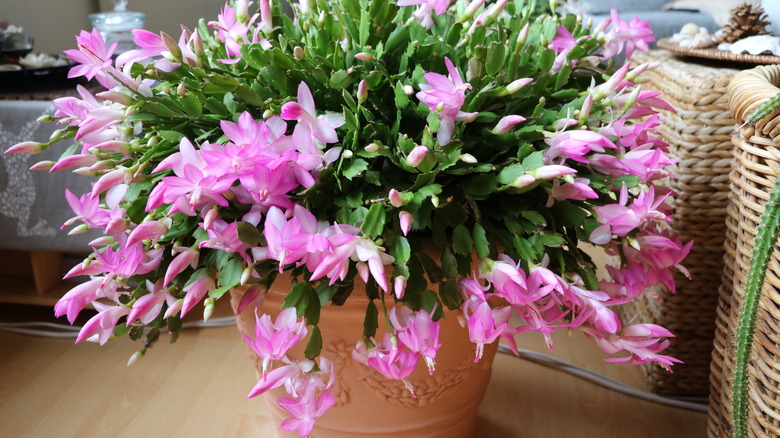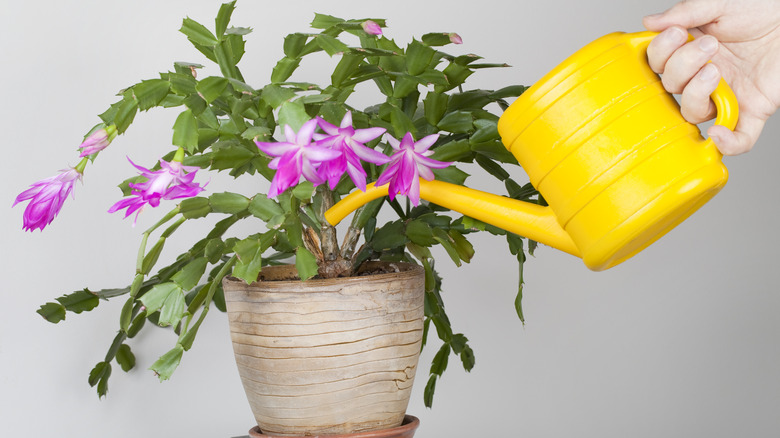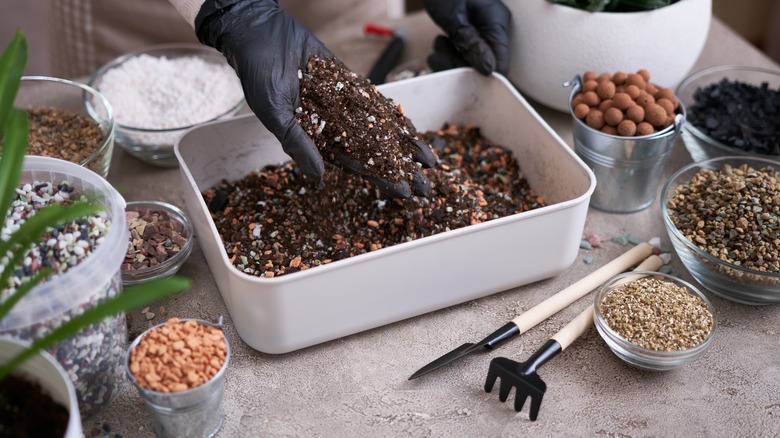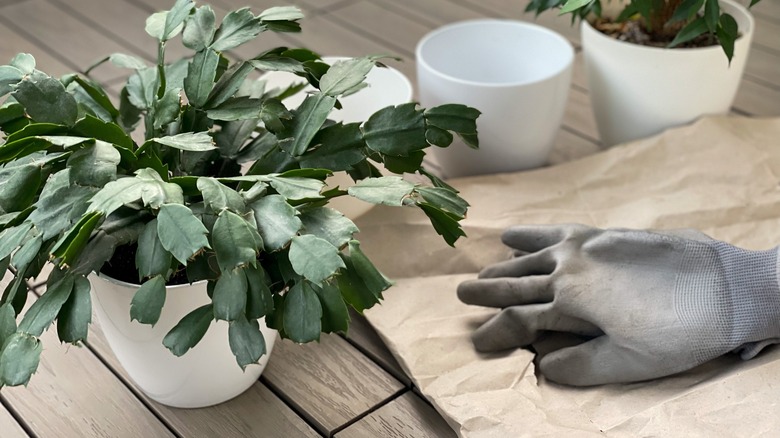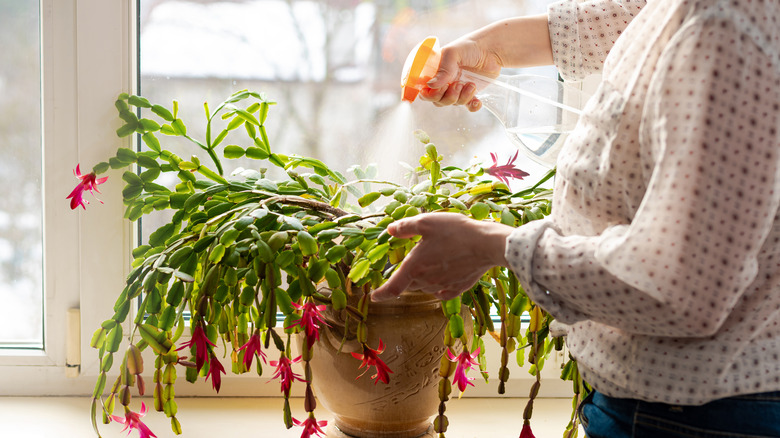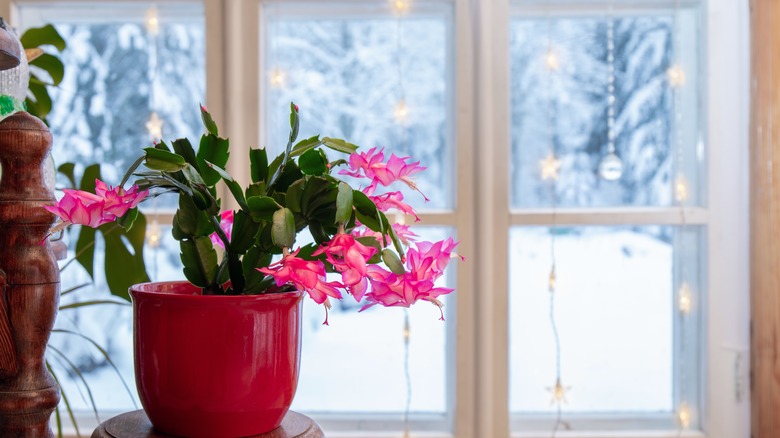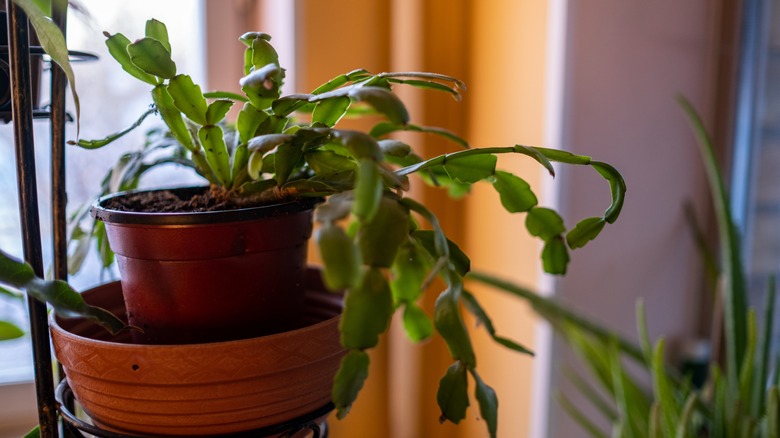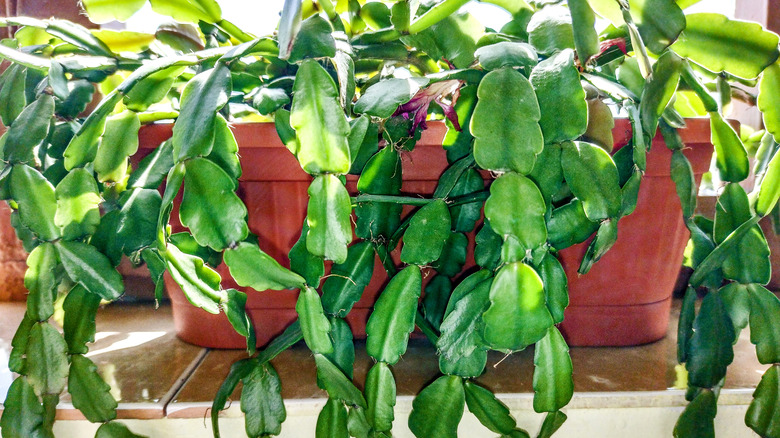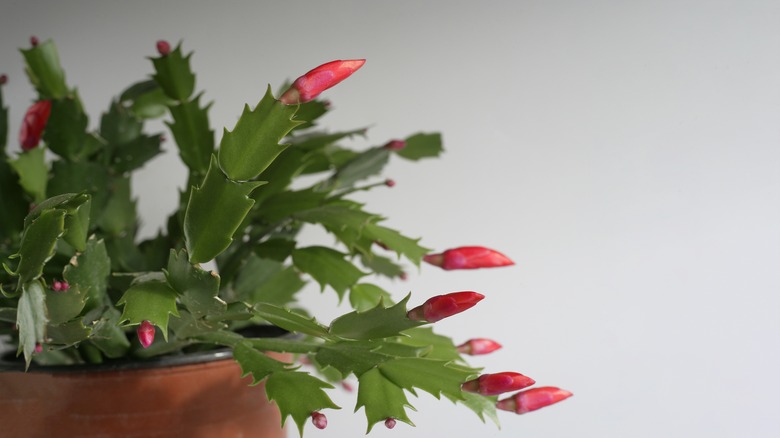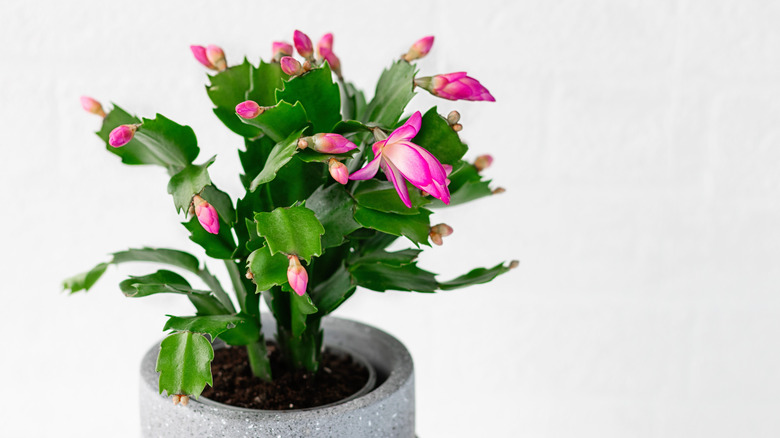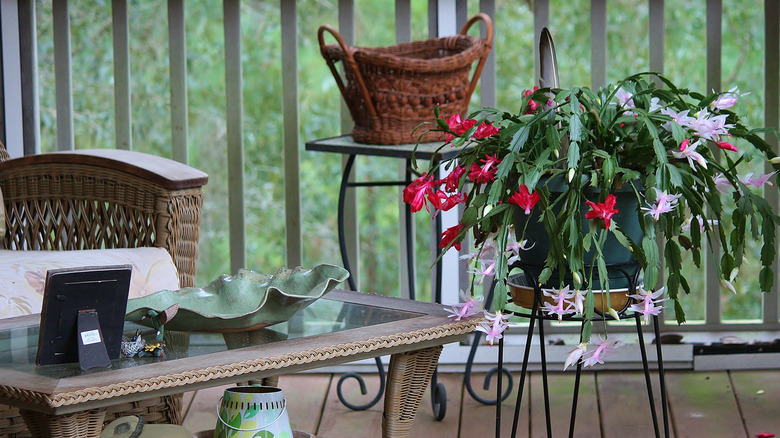Deadly Mistakes To Avoid Making With Your Christmas Cactus
We may receive a commission on purchases made from links.
The Christmas cactus (Schlumbergera bridgesi) is quite a charming plant. It's easy to grow and sprouts bright, cheery blossoms in the midst of winter when we could all use a little pick-me-up. If you scoffed when you read that these plants are easy to grow because yours is looking a little worse for wear, it could be a sign that you're giving your plant a bit too much attention. These little succulents practically thrive on neglect, compared to many other houseplants, requiring very little water and preferring to be a bit rootbound.
The good news is that problems with these plants are often simple and easy to correct. You won't need to spend hundreds of dollars at the garden center or scour the internet trying to figure out what to do. It's easy to learn how to care for your Christmas cactus houseplant. A few simple and inexpensive fixes can solve many of the problems you're having and get you back on track quickly. You can then get back to enjoying your plant rather than worrying about it.
Drowning your plant
Christmas cacti are succulents, so they're good at storing water on their own. They're also epiphytes, which means that in their natural habitat, they often grow on other plants. They find their own sources of food and water, so they're not parasitic, but their roots are sometimes exposed because of the way they grow. As a result, their roots are very fine and able to pull water from the air as well as the soil. Clearly, they are quite good at finding and extracting the water they need to survive. You need to provide water, of course, but it's easy to offer too much, and Christmas cacti with wet feet are very susceptible to root rot.
To avoid overwatering, begin by planting your cactus in a pot with plenty of drainage holes. Wait to water your Christmas cactus until the soil is dry to the touch. When you do water, it's best to do so in the sink. Wet the soil thoroughly and then allow the excess water to leave the pot through the drainage holes in the bottom. Let the pot thoroughly drain before placing your plant back in its normal home. This is a better plan than setting the pot in a saucer to catch any water drips since these plans don't like sitting in a dish of water.
Growing your Christmas cactus in the wrong soil
Potting soil seems like the logical choice when growing plants indoors, but traditional potting soil is too heavy for a Christmas cactus. While not full-blown cacti as their name suggests, these plants are succulents with very fine roots that need some air. Planting a Christmas cactus in heavy soil is like putting lightning bugs in a jar with no air holes in the lid — the fun is short-lived.
Many houseplant enthusiasts are embracing a new soil alternative: lightweight expanded clay aggregate (LECA). This unexpected potting soil replacement is intriguing and may be well worth investigating for its ability to balance a plant's air and water needs. LECA has shown promise as a growing medium for succulents, and gardeners who like to experiment may want to check it out. But there is nothing wrong with sticking to traditional soil if you're more old school or already nervous about keeping your plant alive.
For best results, make your own succulent potting soil using two parts traditional potting soil and one part clean sand. Another good recipe is a mix of 40% perlite and 60% peat moss. Be warned, however, that peat moss deteriorates quickly. You may need to repot your plant every few years to keep the soil fresh if you go this route. If you don't want to make your own soil, buy a succulent mix online or at your local garden center.
Giving your plant too much wiggle room
Some plants need a little breathing room, but the Christmas cactus prefers to be a bit root-bound. You don't want your plant to become overly root-bound, though, as this causes problems. When the plant has too many roots or they become too large, they can fill the pot so much that there is little room left for soil. When this happens, the plants dry out very quickly. This takes some time with the small roots of a Christmas cactus, however, and repotting too soon makes these plants unhappy.
You should only repot your Christmas cactus about once every three years. Some people wait a bit longer, which is okay when dealing with this particular plant species. Your plant will tell you when it needs repotting by looking a little tired and depressed. You'll also notice that the roots are starting to grow out of the drainage holes in the bottom of the container. Repot your plant in late winter or early spring, making sure it's done blooming first. Then choose a pot that is only about 1 inch larger than the old one, gently loosen the root ball to encourage the plant to adapt to its new home, and place it in the new pot. The root ball should sit about an inch below the rim of the pot.
It's not the heat, it's the humidity
Christmas cacti are native to the rainforests of Brazil where it's hot and humid. Your home may be too dry for their liking. They like a humidity level of about 50 – 60%, and the ideal humidity level in a home is between 30 – 50%. In the winter when the air is dry, some homes may dip below even this threshold, which is unhealthy for a Christmas cactus.
You don't want to raise the humidity level in your entire home to accommodate a plant, especially since this can encourage mold and insect pests. You can, however, raise the humidity level around the plant. One way to do so is to lightly mist it with water occasionally. You can also place a small humidifier in the room with your cactus or build a humidity tray. To make a humidity tray, place some pebbles on a tray with a lip and fill it halfway with water. Set the tray next to the plant to raise the humidity level in the immediate area. For a simpler solution, place your Christmas cactus in your bathroom when you take a hot shower.
Okay, maybe it is the heat
Rainforests are humid, and they're also centered around the equator where it's warm. Despite its wintry name, a Christmas cactus sitting on a windowsill during the winter months may get too cold. When budding, the plants like a temperature between 55 and 65 degrees Fahrenheit, but the rest of the year they prefer a much warmer 70 to 80 degrees. The plants will generally forgive higher temperatures, but they won't do as well if the temperature gets too low.
Keep your plant happy by setting it in a draft-free space. Remember that air conditioners, dehumidifiers, and other appliances can create a draft where there isn't one naturally. So do doors and vents. It's best to avoid cold windowsills in the winter as well. Even if the sun keeps the temperature up during the day, the window glass and sill can get quite cold when the sun goes down.
Feeding your Christmas cactus too little
A Christmas cactus will put on a stunning floral display each year, but it needs to replenish nutrients after it's done blooming — and it needs fertilizer to do that. But many people skip fertilizing their plants for fear of getting it wrong. Admittedly, it can be scary. Read one article about burning your plants with too much fertilizer, and you may decide to leave well enough alone. But plants need nutrients, and the soil in a potted plant doesn't get any unless you provide them.
Fortunately, Christmas cacti are easy. All they need is a balanced 10-10-10 or 20-20-20 fertilizer. You can even keep your Christmas cactus nourished with common kitchen scraps. Once a month, provide liquid fertilizer at half strength. Stop fertilizing in September so that the plant shifts focus from growing vegetation to setting flowers. Resume fertilizing again when the plant is done blooming. You'll know it's done blooming when it stops setting new flowers and the old flowers drop off.
Failing to prune
Skipping the pruning won't literally kill your plant. But if you don't prune your Christmas cactus, it will likely grow into a lanky, spread-out eyesore and lose its appealing shape. Pruning also promotes new branches and flowering. Prune your cactus about a month or two after it blooms so that it has time to recover from the energy-draining flowering process. When it has recovered, it will start to sprout new growth, and this is when you should spring into action. Pinch or cut back the leaves, removing one or two segments at a time. While you're working, remove any damaged leaves or stems as well. The end goal is to have a compact, bushy shape.
As a bonus, you can easily grow a new Christmas cactus from the leaves you remove when pruning. To do so, prune a leaf section of two or three joints from the parent plant. Place it in well-draining potting soil. Keep the soil moist but not wet, and place the cutting in bright, indirect light. The cutting will form new roots in about two or three weeks and start to grow, creating a new plant.
Missing nap time
Toddlers tend to get cranky when they miss their usual naptime — and so can Christmas cacti. Those beautiful blooms that the plants are known for require a brief dormancy period. Some plants are fussier about this than others, but in nature they typically experience 13 hours of darkness a day, starting in September or October, that lasts for about eight weeks. This darkness is accompanied by a drop in nighttime temperatures, which fall to between 55 and 65 degrees Fahrenheit. The temperature in your house likely stays about the same all year, and this can prevent a stubborn Christmas cactus from blooming.
To mimic the right conditions in your home, move the plant into a cool dark garage or basement at night beginning in October. If this isn't possible, cover the plant with a dark cloth or sheet for 13 hours a day to provide the necessary darkness. If the plant is too large to move, lower the temperature in the room as much as you can without making yourself or others in your household uncomfortable. Try to place the plant in a room where you can control the heat separately from the rest of the house, if possible. Don't stress if you can't do this. Christmas cacti are prolific bloomers and will often perform under less-than-ideal conditions, so just do the best you can.
Moving a budding Christmas cactus
The Christmas cactus is pretty forgiving about most things, but they are prone to dropping buds if they experience even mild discomfort once they start to set flowers. This is very frustrating for growers who anticipate lots of showy flowers, only to see them fall off the plant before they open. Bud drop can be the result of almost any environmental change, including changes in temperature, lighting, or location.
To avoid bud drop, keep the conditions around your plant consistent. Never move it after it starts to bud, and monitor the area around the plant for potential environmental changes so that you can stop them before they happen. Extreme temperature changes at this stage will cause issues, so make sure that a radiator near your plant isn't going to kick on during a cold snap, for example. If you live in a warm climate and have been growing your cactus outside, don't bring it inside once it has set buds. Obviously, you should bring the plant in if temperatures are expected to dip low enough to kill it, but expect the buds to drop if you are forced to do so. Don't change the amount of light your plant gets either — now is not the time to install those new blinds.
Getting the lighting wrong
When we hear the word cactus, we tend to think of a bright and sunny desert, but it's important to remember that this isn't where Christmas cacti grow. They live in rainforests where the sunlight is filtered through a dense canopy of leaves. Setting a plant in a bright, south-facing window where it will get hours and hours of direct sunlight may seem like a good idea, but it can burn the plant's leaves or make them turn a reddish color rather than maintaining their natural green hue. Too much shade can be equally problematic, however. Getting the lighting right can prevent your indoor Christmas cactus from dying.
The solution is to place your Christmas cactus in a bright, sunny room where it can bask in copious amounts of indirect light. Placing them in an east-facing window also works well. A south-facing window isn't necessarily forbidden, but make sure it's a somewhat shaded window where the plant won't receive direct sunlight all day long. If you want to keep your plant outdoors during the summer, you can place it under a covered porch or hang it under a tree. Some shade is fine as long as it's not deep shade.
